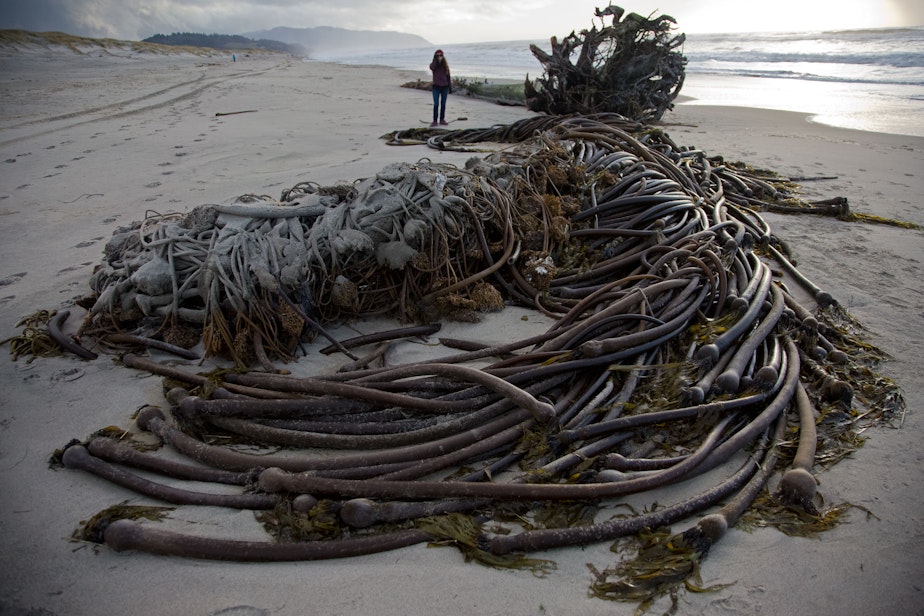Struggling Northwest kelp forests sending out an SOS. Help is coming

There's a rallying cry at various bays and beaches up and down the West Coast; it's "Help the kelp!" The towering brown seaweed with the floating bulb on top is in steep decline. That's alarming because underwater kelp forests provide shelter and food for a wide variety of sea life. The crew now answering the call runs the gamut from seaweed farmers to hammer-wielding scuba divers and might some day include sea otters and octopuses.
One of the first places where people are experimenting with how to regrow kelp in the Pacific Northwest is intriguing, too. Elliott Bay in Seattle features some of the most built up and industrialized waterfront in Washington state.
"What can these kelp, these urban kelp as we call them, tell us about resilience?" is how Kathleen Hurley, a senior environmental program manager with the Port of Seattle, framed the research her agency has embarked upon in partnership with the Seattle Aquarium.
"It's a surprising place to discover that we have these vibrant ecosystems that are thriving in a very transformed landscape," Hurley said in an interview by the bayshore just a few blocks from the downtown skyscrapers.
Kelp beds are underwater biodiversity hot spots and foundational to the marine food web. Clumps of kelp serve as nurseries for many species. Young rockfish and herring, for example, find food and refuge there. Nowadays there is also interest in promoting kelp to serve as a buffer against ocean acidification.
Sponsored
“The more we look into it, the more valuable it is,” Port of Seattle Commissioner Fred Felleman said. “It really is like the manna of the sea.”
Scientists have multiple theories for why kelp forests are disappearing in many places and holding on elsewhere. Marine heat waves and climate change more generally could be a cause. Pollution, development and unchecked predation from other marine animals are also culprits.
In any case, there is a noticeable through line of concern and a gathering tide of action from British Columbia to California to regrow the species that makes the canopied forests, bull kelp.
"I think kelp is having a moment right now," Hurley observed.
Hurley said restoration techniques are still in the early stages. One of the things the port and its collaborators tried is putting twine strings embedded with baby kelp in the water near the shore. The partners deployed five “seed anchors” in Elliott Bay.
Sponsored
"Those grew for a little while,” Hurley said. “But then we suspect that kelp crabs really enjoyed eating those tender young kelp fronds."
The Puget Sound Restoration Fund has reported some initial success with this strategy of anchoring twine seeded with small kelp to the seafloor on the west side of Puget Sound. The nonprofit just got an $800,000 grant from the U.S. Environmental Protection Agency to scale up outplanting projects at scattered sites throughout the Sound.
Another restoration strategy focuses on predator control. Hurley said the Port of Seattle recently put octopus houses on the seafloor around its kelp seedings to attract more octopuses, which feed on kelp crabs.
On the Oregon and California coasts, it’s a booming population of purple sea urchins that are chomping on kelp. They are creating barren areas devoid of kelp, now dubbed "urchin barrens." One option to deal with that: reintroduce sunflower sea stars and sea otters, both of which prey on urchins. These are longer-term initiatives, though.
In the short term, the Oregon Kelp Alliance is recruiting scuba divers to smash sea urchins at three experimental sites along the Oregon Coast. One of the Kelp Alliance’s lead scientists, Oregon State University marine ecologist Sarah Gravem, described this project to OPB.
Sponsored
"We’re going and having really, really focused small-scale culling events where we do go down and literally smash them with a hammer to at least clear small patches so that the kelp can grow in little oases, and that can serve as the source of new kelp in the future," she said.
Gravem is keen to see the sunflower sea star reintroduction tried soon because she freely concedes that hammer-wielding divers are not a practical long-term solution. A newly published study she co-authored with Aaron Galloway of the University of Oregon’s Institute of Marine Biology presented encouraging evidence that if sunflower sea stars were dropped on urchin barrens, the sea stars would start munching their way through the kelp's enemies.
A captive rearing facility would need to be established to launch any sunflower sea star restoration program. The wild population on the Oregon and Washington coast was almost completely wiped out over the past decade by sea star wasting disease. The complementary sea otter reintroduction is being championed by the nonprofit Elakha Alliance, but that still has a long evaluation process to go through with an uncertain outcome.
Yet another restoration technique is kelp farming. Commercial aquaculture farms could serve as seed banks, releasing spores into the currents to spawn wild kelp forests nearby. The proposed Vashon Kelp Forest offshore of Vashon Island, Washington, is a leading example of this sort of project that combines commerce and conservation.
Port of Seattle Commissioner Felleman said he is optimistic about what is achievable with kelp restoration overall because he said the marine environment has demonstrated resilience.
Sponsored
"If you stop kicking it while it’s down – you just lighten up on your footprint – and it rebounds,” Felleman said. “We're just trying to find out what it is that is limiting its growth and trying to be more cognizant of some of the things we can do.”
Last year, the Washington Legislature set a goal to conserve and restore 10,000 acres of kelp forests and eelgrass meadows by the year 2040. This year, the state Department of Natural Resources is taking public input and working out a plan for how to accomplish that.
Copyright 2023 Northwest News Network

